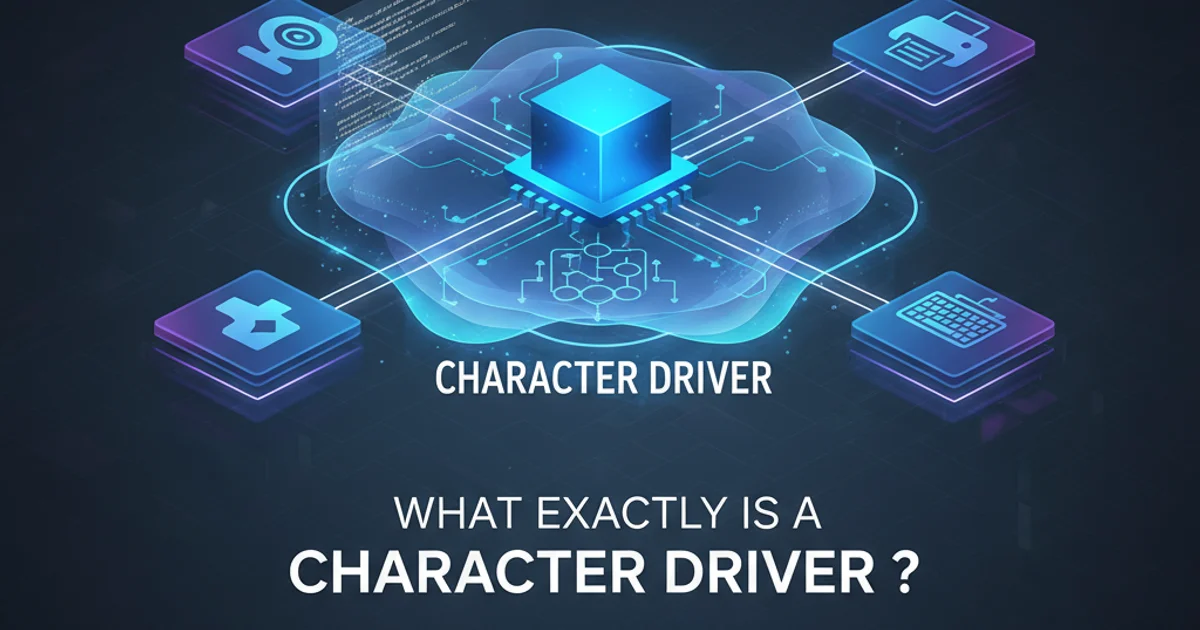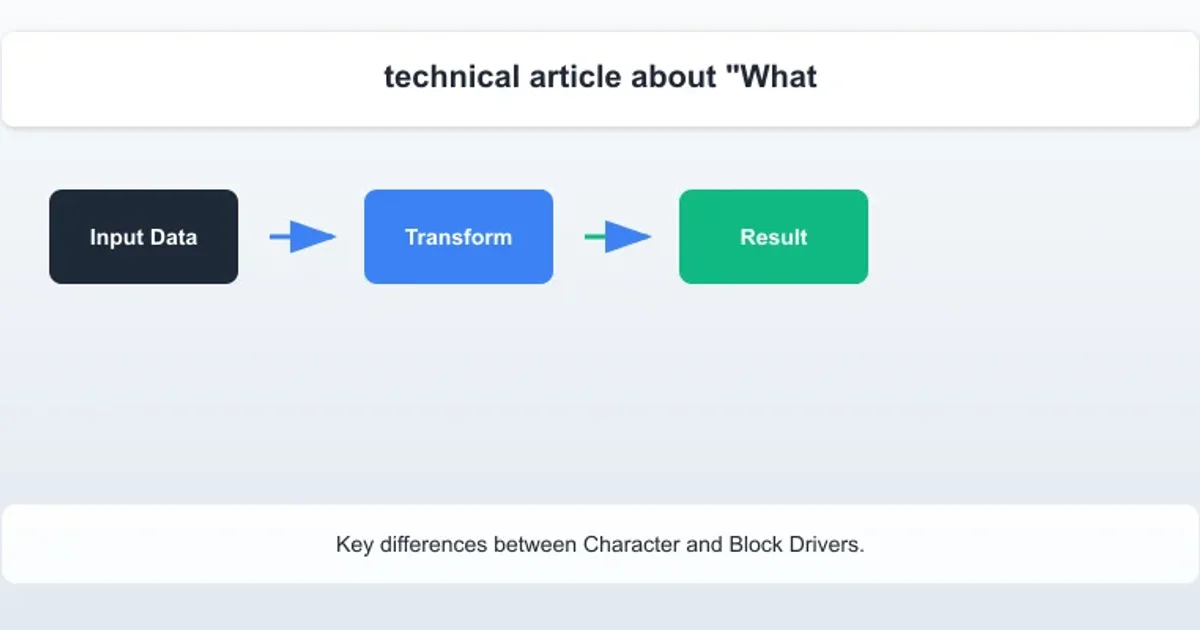What exactly is a character driver ?
Categories:
Understanding Character Drivers: The Gateway to Device Interaction

Explore what character drivers are, their role in operating systems, and how they facilitate communication with hardware devices in a byte-stream fashion.
In the realm of operating systems, device drivers are crucial software components that enable the OS to interact with hardware devices. Among the various types of drivers, character drivers hold a fundamental position. They provide a simple, byte-oriented interface to devices, treating them as streams of characters. This article delves into the specifics of character drivers, their architecture, and their importance in modern computing.
What is a Character Driver?
A character driver is a type of device driver that manages hardware devices which transmit or receive data as a stream of characters (bytes). Unlike block devices, which handle data in fixed-size blocks, character devices do not have a fixed block size and can be accessed sequentially, byte by byte. Examples of devices typically managed by character drivers include serial ports, parallel ports, sound cards, keyboards, mice, and even some custom hardware interfaces. The operating system interacts with these devices through standard file operations like open(), read(), write(), and close(), making device access consistent with file system operations.
flowchart TD
User_App[User Application] -->|open(), read(), write()| VFS(Virtual File System)
VFS -->|Device Node (/dev/ttyS0)| Char_Driver[Character Driver]
Char_Driver -->|Hardware-specific commands| Hardware[Hardware Device]
Hardware -->|Data/Status| Char_Driver
Char_Driver -->|Return data/status| VFS
VFS -->|Return data/status| User_AppInteraction flow between a User Application and a Hardware Device via a Character Driver
Key Characteristics and Operations
Character drivers are defined by their ability to handle data as a continuous stream. This means that applications can read or write any number of bytes at a time, and the driver will manage the underlying hardware interactions. The core operations provided by a character driver typically mirror those of file I/O:
open(): Initializes the device for use.release()(orclose()): De-initializes the device and releases resources.read(): Reads data from the device.write(): Writes data to the device.ioctl(): Performs device-specific control operations that don't fit theread/writemodel (e.g., setting baud rates for a serial port).
These operations are exposed to user-space applications through special device files, usually located in the /dev directory. For instance, /dev/ttyS0 might represent a serial port, and /dev/input/mice for a mouse.
#include <linux/module.h>
#include <linux/fs.h>
#include <linux/cdev.h>
#define DEVICE_NAME "mychardev"
#define CLASS_NAME "mychardev_class"
static int major_number;
static struct class* mychardev_class = NULL;
static struct cdev my_cdev;
static int dev_open(struct inode *inodep, struct file *filep) {
printk(KERN_INFO "mychardev: Device opened\n");
return 0;
}
static ssize_t dev_read(struct file *filep, char *buffer, size_t len, loff_t *offset) {
// Placeholder for reading data from device
printk(KERN_INFO "mychardev: Reading from device\n");
return 0;
}
static ssize_t dev_write(struct file *filep, const char *buffer, size_t len, loff_t *offset) {
// Placeholder for writing data to device
printk(KERN_INFO "mychardev: Writing to device\n");
return len;
}
static int dev_release(struct inode *inodep, struct file *filep) {
printk(KERN_INFO "mychardev: Device closed\n");
return 0;
}
static struct file_operations fops = {
.open = dev_open,
.read = dev_read,
.write = dev_write,
.release = dev_release,
};
static int __init mychardev_init(void) {
printk(KERN_INFO "mychardev: Initializing the Character Device\n");
// Allocate a major number dynamically
major_number = register_chrdev(0, DEVICE_NAME, &fops);
if (major_number < 0) {
printk(KERN_ALERT "mychardev: Failed to register a major number\n");
return major_number;
}
printk(KERN_INFO "mychardev: Registered with major number %d\n", major_number);
// Create device class
mychardev_class = class_create(THIS_MODULE, CLASS_NAME);
if (IS_ERR(mychardev_class)) {
unregister_chrdev(major_number, DEVICE_NAME);
printk(KERN_ALERT "mychardev: Failed to create device class\n");
return PTR_ERR(mychardev_class);
}
printk(KERN_INFO "mychardev: Device class created\n");
// Create device node in /dev
device_create(mychardev_class, NULL, MKDEV(major_number, 0), NULL, DEVICE_NAME);
if (IS_ERR(device_create(mychardev_class, NULL, MKDEV(major_number, 0), NULL, DEVICE_NAME))) {
class_destroy(mychardev_class);
unregister_chrdev(major_number, DEVICE_NAME);
printk(KERN_ALERT "mychardev: Failed to create the device\n");
return PTR_ERR(device_create(mychardev_class, NULL, MKDEV(major_number, 0), NULL, DEVICE_NAME));
}
printk(KERN_INFO "mychardev: Device created in /dev/%s\n", DEVICE_NAME);
return 0;
}
static void __exit mychardev_exit(void) {
device_destroy(mychardev_class, MKDEV(major_number, 0));
class_unregister(mychardev_class);
class_destroy(mychardev_class);
unregister_chrdev(major_number, DEVICE_NAME);
printk(KERN_INFO "mychardev: Goodbye from the Character Device!\n");
}
module_init(mychardev_init);
module_exit(mychardev_exit);
MODULE_LICENSE("GPL");
MODULE_AUTHOR("Your Name");
MODULE_DESCRIPTION("A simple Linux character device driver");
A basic Linux character device driver skeleton in C.
Character Drivers vs. Block Drivers
The distinction between character and block drivers is fundamental to understanding device management in an operating system. While character drivers handle data as a stream of bytes, block drivers manage devices that store data in fixed-size blocks, such as hard drives, SSDs, and CD-ROMs. Block devices are typically accessed randomly, allowing the OS to read or write any block independently. Character devices, on the other hand, are often accessed sequentially, and their operations are not buffered by the kernel in the same way block devices are. This difference in access patterns and data handling dictates the driver's internal structure and the interface it presents to the operating system and user applications.

Key differences between Character and Block Drivers.
In summary, character drivers are essential components that bridge the gap between the operating system and a wide array of hardware devices that operate on a byte-stream basis. They provide a standardized, file-like interface, simplifying device interaction for user applications and enabling the rich ecosystem of peripherals we use daily.